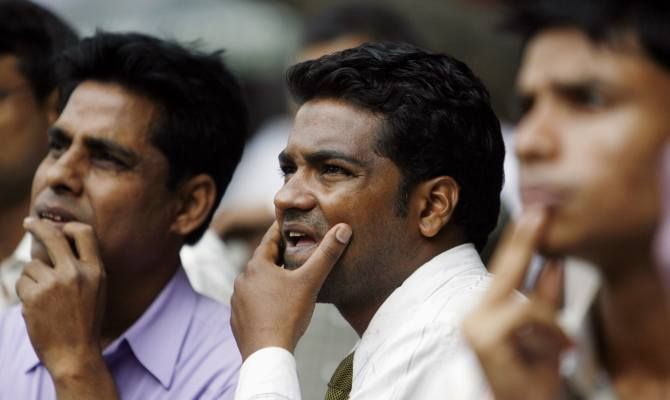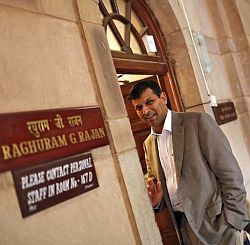 'If banks don’t reduce interest rates in line with the fall in market rates, large corporations will move away'.
'If banks don’t reduce interest rates in line with the fall in market rates, large corporations will move away'.
'If I have a big problem, I go back to my creditor and say ‘I can’t make my payments to you; so, why don’t you take a haircut?'
'I am not looking for any new opportunities for when my term here comes to an end'.
Reserve Bank of India Governor Raghuram Rajan spoke to Business Standard in an exclusive interview.
Edited excerpts:
What was the rationale behind Tuesday’s policy stance?
We have cut the rates twice.
These have to be absorbed and transmitted. We are giving it time to be transmitted.
We have also seen some upturn in inflation in the past three months, some of which is because of the base effect.
But some upturn is due to vegetable prices. The weather hasn’t been that favourable.
And, we have the monsoon coming up; it affects some prices. Let’s see how the transmission takes place.
We are fairly confident that with the liquidity situation easing in April and the credit growth relatively modest, banks have the incentive to pass it on.
We will also get more information on how recent developments on inflation are playing out.
You seem to be quite upset with banks in terms of the delay in policy transmission.
We will take steps to improve the transmission mechanism.
But at the same time, banks will also have to take a view.
The question is where we should be as a country.
Ideally, a lot of rates should be priced at a market rate, such as the call money rate.
That pricing should happen both on the lending side, as well as the borrowing side.
In most countries, you don’t have a situation in which banks decide what rate that should be; it is a market-based rate.
We need to move towards that.
The corporate sector does not care from where the money is coming as long as it is cheap.
So, if banks are not willing to cut rates, the borrower will go to the commercial paper market.
I believe banks can’t say ‘we believe in this kind of a base rate mechanism’.
They have to move towards a base rate mechanism that reflects their marginal cost of funds.
After the policy announcement, you had an interaction with banks. Do you think they will accept the marginal cost theory?
If they don’t reduce interest rates in line with the fall in market rates, large corporations will move away.
Maybe that is what banks would like to see.
But I can’t believe they would like to see that happen in a major way.
Recently, the government increased the small savings rate amid softening interest rates. Does it send a wrong signal?
I agree with the basic premise that the small savings rate should move along with the market interest rate.
It cannot be fixed at a level; otherwise, it becomes the floor.
Going forward, it has to become more flexible.
With 5.8 per cent Consumer Price Index-based inflation projected for December and a real rate of 1.5-2 per cent, as you had earlier said, would the scope for further rate cuts be limited?
No. That is our expectation of what inflation will be at the end of the year.
Then, you could gaze on how much room there is.
As I said, if you are optimistic about the market, you will look at the 1.5 per cent figure and if you are pessimistic, you will say there is no room for a rate cut.
What is important is the way inflation moves over time.
A projection of 5.8 per cent does not necessarily mean there is realisation.
If the disinflationary process is stronger, if the monsoon is a good one, if vegetable prices do not pick up that much, it is quite possible that disinflation will be stronger.
The point we are making today is we want to look at more data to get more confidence.
So, 5.8 per cent could be revised, say, three months down the line?
Of course, it will be, almost surely, be revised according to the inflation. As inflation evolves, there might be room or there might not be. We have to see.
Have you started factoring in RBI’s four per cent inflation target?
As was the case last year, we have a short-term goal and a medium-term goal.
The short-term retail inflation goal was eight per cent and the medium-term goal six per cent.
Now, our short-term goal for the end of the year is six per cent and medium-term goal is four per cent.
We have two years to go from six per cent to four per cent.
We are not trying to disinflate faster than what is laid out in these goals.
Does it mean if for some reason oil prices collapse further and we reach five per cent earlier, we will push up inflation to get six per cent?
The answer is no.
The concern among market players is if four per cent is factored in and if you have a feeling that this is tough to achieve, RBI might well start raising interest rates.
Remember, we have two years to get to six per cent.
So, there is plenty of time. We have room to disinflate about one per cent a year.
The policy document sounded a positive note that growth would pick up. In the past year, since the new government has taken charge, have you seen things change at the ground level?
There are two ways to ascertain this.
One is through the database and the other is by asking bankers and companies.
I think there is movement on the ground.
Projects have been restarted; projects are being completed after being stuck for a long time.
The database also suggests that.
According to the Centre for Monitoring Indian Economy’s database on stalled projects, the number of such projects and their value is coming down, not as much as you would like, but it is falling because of government action.
Also, new project intentions are rising, which includes private projects, not only government projects.
So, I think we are seeing the beginning of a pick-up.
These are still early days but I am growing more optimistic.
 How serious is the problem of unhedged foreign exchange exposure of Indian companies? There is complacency among players because the exchange rate has stabilised.
How serious is the problem of unhedged foreign exchange exposure of Indian companies? There is complacency among players because the exchange rate has stabilised.
I think it is unhedged to a greater extent than we would like. If they are playing with their own money, there is no issue. But we fear sometimes, some of them are playing with creditors’ money.
If I have a big problem, I go back to my creditor and say ‘I can’t make my payments to you; so, why don’t you take a haircut?’
If you bet big on the dollar remaining relatively low against the rupee and if you win, you will be paying a dollar interest rate.
And, it is all upside for you. It’s like ‘heads I win, tails you lose’, which we worry about.
That is why we are pushing banks to ensure these people hedge by raising their capital requirements.
We cannot micro-manage this process.
Perhaps, the only way to create incentives is to hope there are significant episodes of rupee volatility.
Do we want to engineer those volatilities?
No. Sometimes, small accidents help you keep away from big ones.
RBI says it does not target an exchange rate. Why are interventions in foreign exchange markets so high?
We don’t.
But what is happening is on some days and in some situations, everybody is saying the right place to be is India and Indonesia.
So, when the market fixates on this, we get a lot of money.
If we allow the rupee to appreciate based on all the inflows coming in and if we stop becoming the flavour of the month, a lot of money will go out.
That creates undue volatility for the rupee.
So, our worry is when we see we are the flavour of the month and money is pouring in, should we keep some reserves for when the money will go out?
We also want to tell people ‘go look elsewhere’. . .That is why we say invest in longer-term securities.
I am glad a fair amount of money is coming into equity, not only into debt.
And, the fact that the government debt limit is exhausted means more debt is going to companies.
So, corporations are able to borrow at a relatively lower rate.
We have to be vigilant.
The Economic Survey pointed out India should have foreign exchange reserves of $750 billion to $1 trillion. Do you think that is desirable?
In India, many economic commentators say somehow, we could tag it with the level of the rupee.
Implicitly, what they have in mind is you buy so much that it moves the rupee to whatever level you want.
There is a cost to that.
You are financing another country by building reserves at a very low interest rate.
To the extent reserves are precautionary, doing some of this is warranted, such as protecting against a significant crisis, etc.
But beyond a certain level, you have to recognise there is a potential cost to it.
A lot of people will say we should intervene to keep the rupee really low so that our exports flourish.
That isn’t necessarily true, as your import costs will also rise.
Today, most exporters also import a lot; it is not an unmitigated blessing.
Also, if you push the rupee far down, inflation will pick up.
Sometimes, the commentary on this issue is very shallow and one-sided.
It says buy more and more dollars and we will be really competitive and that will be Nirvana!
What we have to do is be careful and follow a policy that is moderate, not allow too much appreciation when there is a lot of money flowing in and, at the same time, not try to aim to take the currency to some level.
We are not trying to fix a level for the rupee. . .we are too much of an open economy for that to succeed in the longer run.
The Economic Survey was talking about $750 billion over a long period.
The appropriate level of reserves will depend on the size of the economy.
Now, we are a $2-trillion economy and we have reserves of about $350 billion.
If we become a $5-trillion economy and are still developing, there might be a different level of reserves at that point.
What gives you the confidence that the government will not push the fiscal deficit target further?
This is where the credibility of the government comes into play.
Market participants will rely on the government to deliver on its promise to stick to the fiscal consolidation path.
There is an open question that the expenditure reforms committee and other committees raised -- the country needs more mechanisms to ensure there is either a watchdog on the size of the fisc, or there are hard commitments.
Hard commitments in a country like ours are difficult, unless they are constitutional commitments that have to go through multiple legislation.
My sense is the government has firmly said this is a one-year postponement.
Certainly, I have to believe that.
But there is a need for an open debate on the lines the expenditure committee has suggested -- that we should build more institutions that ensure the consolidation process.
The Finance Bill has proposed to shift money market regulations from RBI by amending sections 45U and 45W of the RBI Act. What will be the implications of that?
The finance minister has publicly said he will make a statement in Parliament. So, we have to wait for that.
I have said quite explicitly that those provisions aren’t related to the debt management office.
The DMO is independent of RBI, the Securities and Exchange Board of India and, presumably, of the government.
So, for DMO, you don’t need to shift regulations from RBI to Sebi. In that sense, we have to wait and see.
Technically speaking, there is no necessary connection.
After the government decided to selectively infuse capital in public sector banks, those that didn’t receive capital went to LIC. Are you worried that LIC is investing in so many banks?
We have to examine how much any single entity can own in the entire banking system.
On Monday, Ambit Capital came out with a report saying you weren’t interested in continuing as RBI governor beyond the three-year tenure. And, you were likely to succeed Christine Lagarde at the International Monetary Fund.
(Laughs) This is one of those speculative stories that have speculation at every level.
Lagarde is doing a fine job at Washington and that job is not open.
She might well go for a second term.
I am in the middle of my tenure here.
I am not even thinking about what would happen at the end of my three-year term.
Earlier, some people wanted me to pack off to the BRICS (Brazil, Russia, India, China and South Africa) Bank.
They seem to find a new job for me every few months.
I have said it and will say it again -- I have a perfectly good job in academia.
I am not looking for any new opportunities for when my term here comes to an end.
Right now, I want to do the best job I can for whatever time I am here.
When are the payments bank and small finance bank licences expected to be announced?
I am hopeful we can do it in six months from the last date of receiving applications. That is an upper limit.
Image: (Top) People look at a large screen displaying India's benchmark share index, on the facade of the Bombay Stock Exchange building in Mumbai. Photograph: Arko Datta/Reuters; (Bottom) RBI Governor Raghuram Rajan. Photograph: Reuters











